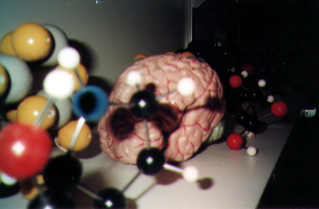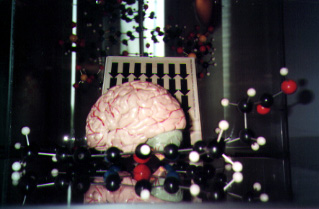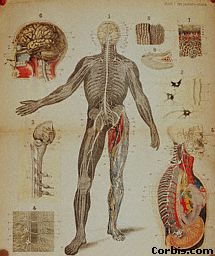Part 2: Section 1 |
||||
ECSTASY: The Chemical “urge to love” Reexamined |
||||
|
Photo courtesy of Community Webshots
|
||||
| It has been pointed out by F. Husemann that: | ||||
|
||||
| So are there any contradictions if one assumes that ecstasy works by increasing levels of a particular chemical, namely serotonin? | ||||
| Before I turn to exploring the contradictions I want to note the so-called phenomenon of “fad science.” We all heard of fad diets and such but for many like myself, it was hard to accept the fact that certain scientific theories are used over and over without much substance to them. | ||||
| For
instance, serotonin is linked to at least a dozen other drugs and disorders, particularly
those of the central nervous system. They include depression, obsessive-compulsive
disorder, stroke, schizophrenia, obesity, pain, hypertension, vascular disorders, and even
nausea and migraines! Before I turn to the problems of the serotonin hypothesis, it is
important to see why it has become so popular and the types of hypothesis it has produced.
|
||||
Photo by Rachel Berman |
||||
| Theoretically, a single chemical such as serotonin is capable in participating in various chemical reactions that produce different products that can, depending on their reactive specificity, go on to react further and cause different products to form. Also various other factors such as relative size of ionization constants of these reactions could influence which reactions predominate and thus which products are present in greater amounts. Therefore, different behavioral patterns may arise depending on the chain of reactions caused by ecstasy and by the concentrations of various chemicals produced. It is conceivable that the chemical reactions behind these behavioral patterns can potentially start from the influence of a single chemical. However, as Yale neuropsychologist Thomas J. Carew points out: “Serotonin is only one of the molecules in the orchestra.” So what are the other molecules and instruments that we are missing in this account? | ||||
| Unfortunately, we can only hypothesize at this point, partly because most of the research is done on rats, not humans, and the experiments, which are done on humans, have quite “shaky data.” It is difficult to reach conclusions from data produced from retrospective research on humans, rather than prospective research. As pointed out at the Novartis Foundation Press Conference: “There is the difference between studying the brains of humans who say they have taken MDMA in the past (whether recently or not) and studying the brains of humans before and after actually giving them MDMA.” In the first case there are obvious methodological difficulties. For example, differences in the brains of MDMA users, compared to non-users who are the control group could be preexisting. Another boundary in understanding the effects of ecstasy has to do with ethical questions. As Professor Ricaurte mentioned at the conference, it is certainly unethical to ask human subjects to be involved in a study whose purpose is to “see whether or not we can destroy serotonin nerve terminals in you brain” and thus get a step closer to other routes of MDMA. | ||||
| So there are uncertainties in the method by which the serotonin theory is constructed and thus its reexamination is necessary. You cannot trust a hypothesis based on an experiment that has shaky data to begin with. | ||||
Photo by Rachel Berman |
||||
From my research, I noticed that most studies make a lot of generalization about the substances in question. Human beings always strive to sort everything out on shelves.Frankly, this was my problem when I first started to work on this project. I wanted definitive answers. I had big questions and expected to find similar scale answers. As for such an inquiry, as well as the serotonin hypothesis, such an approach produces vague answers. I am now convinced that it is better to have solid answers to small questions rather than a conceptual framework based on generalized answers. |
||||
| As I mentioned earlier, researchers generalized the task of serotonin to that of “modification of responses of neurons to a range of neurotransmitters.” From this generalization a theory that serotonin influenced mood came about. Although there is a substantial amount of evidence that serotonin does play a role in mood, its role is more subtle and complex. For example, various experiences of users are very specific. That is, while one user gets in touch with his “inner spirit” and expands his mind in a creative manner, another user gets a depressive effect. In between these two ends of the spectrum of experience, there are countless other experiences, the type and degree of which is so fined tuned that it becomes impossible to think that each was brought about merely by the decrease or increase of a serotonin levels in the brain. | ||||
by Rachel Berman |
||||
| As I mentioned previously, it is conceivable that a single chemical starts an array of chemical reactions that might lead to various behaviors. However, to think of human experience as simply a level of a particular chemical is quite limiting in terms of understanding the nervous system. First of all, there are many other molecules in “the orchestra” that can precipitate in neural communication. Also, chemicals circulating in the fluids of our body can bind and influence neurons, not necessarily at their synapses. | ||||
| Another
important question to consider is that if the “high” is produced by high levels
of serotonin, why is it not produced in all people taking ecstasy? This suggests that
there is something more involved with the experience of the “high.” Even those
researchers who support the serotonin hypothesis agree that the brains of individuals are
different. Such things as memory and the complex phenomenon we refer to as personality
come into play. If they did not, human experience would loose its depth because everyone
would respond to stimulation in the same way. Two people would have an identical
“high.” Obviously this is not the case. The brains of people must be different
in some intricate ways, otherwise the same event would trigger same emotions in two
people, this rarely occurs. Basically, this amounts to the fact that the effects of a
chemical, such as MDMA, depend on other players (the chemicals and neural aggregations
present at the time) as well as what these players are doing at that time.
|
||||
|
Photo courtesy of Community Webshots Photo © www.corbis.com
|
||||
| If
one uses the metaphor of the operation of the orchestra being like the nervous system, it
becomes apparent that two peoples’ brains have the same instruments (neurons,
chemicals, etc.) which make up an orchestra. However, the time at which each instrument
plays by itself or in concord with another, the pitch (levels of a particular chemical),
and amount and types of instruments present (chemicals and specific neural connections
present especially in the vicinity of influence) determine the kind of a symphony played.
The brain in this analogy is also different in persons considered due to their genome,
previous experiences, personality, environment, and other factors, which come into play
when shaping a person’s perception of the external world. When one considers the
endless possibilities of elements (chemicals, neural connections, etc.) that are involved
in the playing out of the symphony, it soon becomes apparent that the symphony, or the
depth of human experience, cannot be entirely based on “the one molecule in the
orchestra.” So are there more molecules we should be thinking about? I would imagine there are tons of chemical players and cofactors involved in the seratogenic pathway. Also, there are likely to be other neurotransmitters involved in producing the effects of ecstasy that we don’t know anything about. However, what is more important to understand is that it is likely that mind altering substances such as Ecstasy may act on areas of the brain which are concerned with concepts of interpersonal relations as a whole. This is the subject of the Section 3: Prozac, Empathy, and Brain Systems. But before we get there, I examine one other system, which nicely parallels our discussion of ecstasy. This system is another drug, namely Prozac. |
||||






